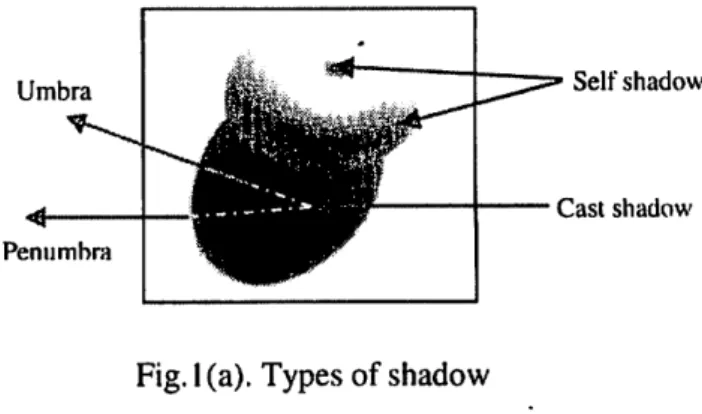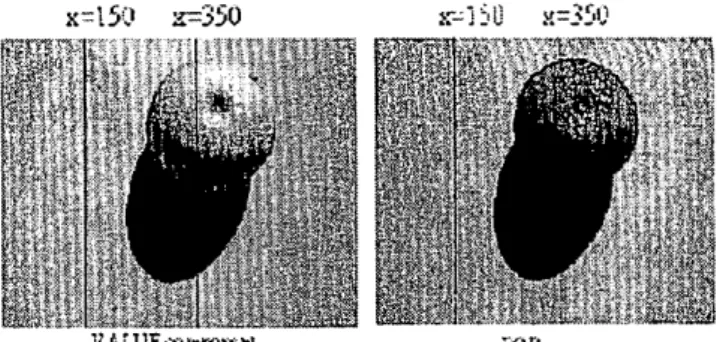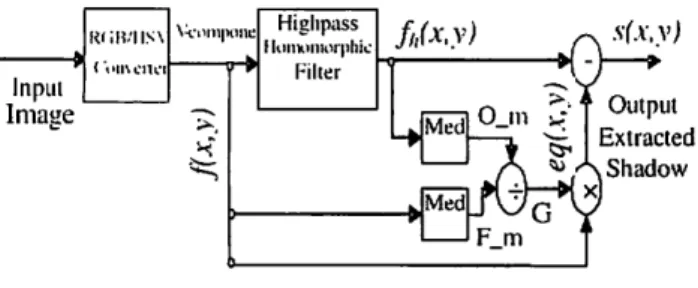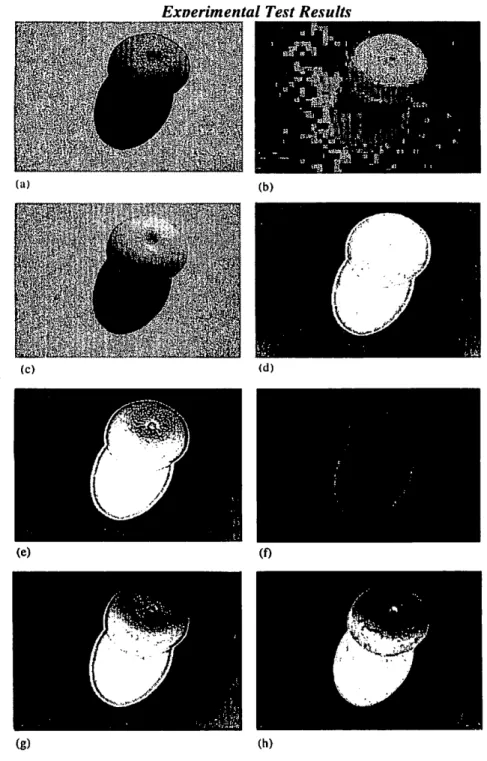Author(s)
Asharif, Mohammad Reza; Etemadnia, Hamideh
Citation
琉球大学工学部紀要(66): 71-75
Issue Date
2004-03
URL
http://hdl.handle.net/20.500.12000/1489
Shadow Identification by Image Components Separation Using Homomorphic System
Prof. Mohammad Reza Asharif
E-mail: asharif@ ic. u-ryukyn.ac.jp Department of Information Engineering.
Ryukyu University
I Senbaru, Nishihara, Okinawa, 903-0213, Japan Phone: +81-98-895-8681, Fax: +81-98-895-8727
Hamideh Etemadnia
E-mail: etemadnia@ic.u-iyukyu.cic.jp Department oflnformation Engineering,
Ryukyu University
Senbaru, Nishihara. Okinawa, 903-0213, Japan
Abstract: In this paper we proposed a new method, in order to extract the shadow area, using the
homomorphic system for more emphasizing on illumination and reflection components separately. Also we use Value component of HSV color space as darkness/lightness of a color, which tends to work better for any images. Furthermore, the presented experimental results which are obtained for shadow identification, show the efficiency of the propose method.
Keywords: Shadow identification, Homomorphic system, HSV color space, Background equalization.
1. Introduction
Shadow occurs when an object totally or particularly occludes directly from the light source. Generally, shadow is divided in two parts: I- Self shadow which is a part of shadow on the main object where is not illuminated by light. 2- Cast shadow, which is the object's shadow on background. Basically, cast shadow itself is divided in to umbra and penumbra. The umbra corresponds to the area
where the light is totally absorbed by object whereas the penumbra is an area of shadow where light is particularly
blocked. Different parts of shadow are illustrated in Fig.
l(a) & l(b). Several approaches based on model [4] or
shadow properties [1,3] have been proposed for shadow identification and classification, especially for detecting self and cast shadow.
As it is clearly obvious, illumination in shadow area is
different from other parts of the image. However the reflection of the shadow area is as equal as non-shadow area for the same object. In the algorithm proposed in this paper we use the homomorphic approach in order to operate on image illumination and reflection separately in
the Fourier domain.
We are using RGB color space images and converted these three components to HSV(hue, saturation, and value) color space images for further processing as it is working better than RGB space for shadow detection [5,6]. Moreover, we are testing the same algorithm on RGB color space components. From the test results, we found for working
on RGB color space, firstly, we have to find the most
dominant component in a RGB color space image to use it
through the algorithm. Converting from RGB color space to HSV color space using the value component of HSV color space which is the darkness/lightness of a color.
tends to work better for any images because intensity
value in the shadow area will be slightly lower than non-shadow area [5]. Experimental results show that it works
well.
The method is applied under the following assumption: 1-The texture of image background is flat or near to flat.
2-Both object and its shadow are within the image. 3- Images are simple (not complicated images).
As an application for shadow identification we can mention to cloud shadow identification and data visibility in cloud shadow covered area in remote sensing images or shadow detection using in Robotic Vision to identify the
object from its shadow.
Shadow detection also can be used in moving object to
identify the real object from its shadow especially in control traffic system.
Umbra Self shadow
Cast shadow Penumbra
Fig. 1 (a). Types of shadow
The body of this paper sketches out a system to recognize
shadow by utilizing of the homomorphic processing in
order to operate on luminance and reflectance of an image separately.
Light Source Shadow making Line
'■■ A S
Ground
Penumbra
Umbra Penumbra
Fig. l(b). Types of east shadow
The procedure of proposed method for identifying shadow has three steps: the first step is the homomorphic filtering process, the second step is the background detection using
median filter for calculating the appropriate gain [2] and the third step is shadow identification.
ln/(.v,y)=
ln/(.\\v)
F{ln /(a-, y)} =
lnr(jc,v)
(3)
+ F{ln r(x, y)} (4)
>,v)
(5)
Whereas, F.(u,v) and F/u.v) are the Fourier transform of illumination In i(x,y) and reflection In r(x,y), respectively. Furthermore, we process F/u.v) by means of linear filler function H(u,v). Therefore, the key to the approach is theseparation of the illumination and reflectance components
achieved in the form shown in Eq. (5):
= H(u, H{u,v)Fr(u,v) (6)
Where Z(u,v) is the Fourier transform of the result.
2. Homomorphic system
When an image generated via physical process, its gray-level values are proportional to energy radiated by a
physical source [7]. Consequently, gray-level values of
image pixels, f(x,y) must be nonzero and finite. A\sof[x,y)
has two multiplication components: 1- illumination i(x,y)
which is determined by the illumination source
2-reflection r(x,y) which is determined by material and color of objects in the image.
f(x,y)=i(x,y).r(x,y)
(1)
Where the nature of i(x,y) component is nonzero and finite, and r(x,y) component is between zero (total
absorption) and one (total reflection).
Theoretically, shadow is the area of an image with the lower illumination value than other parts of the image but the reflection component of an object which shadow area laid on it, is usually the same as other parts. So, for shadow detection, we propose a new method to distinguish
the illumination changes. To this end, we need to separate
two components of each gray-level value f(x,y). Equation (I) can not be used directly to operate separately on illumination and reflection components in frequency
domain, that is:
In the first process, the homomorphic filter will separate
the image illumination and reflection components, by taking logarithm operation of every pixel and converting the gray-level multiplication to addition, for further
performance in result, as shown in Fig. 2.
Input;
—;>LOG_>FFT Process i n;Linear H(U,V)
IFFT EXP
Output
Homomorphic System
Fig.2. Block diagram of the homomorphic system The illumination component of an image generally is characterized by slow spatial variation, while the reflectance component tends to vary abruptly, particularly at the junctions of dissimilar objects. These characteristics lead to associate the low frequency components of the Fourier transform of an image with the illumination and the high frequencies with the reflectance. Although these associations are rough approximation, they can be used for some advantages. At this stage, a good deal of control can be gained over the reflectance component with an appropriate homomorphic filter. In order to emphasize more on reflection coefficients, high pass filter is used as linear processing. To improve the performance of the edge detection, we used the following filter:
:,y)} *¥{i(x,y)}¥{r(x,y)}
(2)
YL<\ ,
(7)Where the constant c has been introduced to control the sharpness of the slope of the filter function in transition between and . D(u,v) is the distance from the origin of the centered transform. This kind of filter is similar to
Gaussian high pass filler. Fig. 3 shows a cross section of
such ii filter.
r,.
Fig. 3. Cross section ion of circularly symmetric filter function
3. Shadow identification
Since luminance is a color feature that is sensitive to shadows as pointed out earlier, we convert the RGB color space components to HSV (Hue, Saturation. Value) color space components. As HSV color space corresponds closely to the human perception of color [6| and it has
been proven that it is more accurate in distinguishing
shadow area than the RGB color space and also gray-scale
space, as:
GSI = 0.299/? + 0.5 87C +0.1 145(8)
V = max(/?,G,fl)
(9)
Whereas; GSI is general transformation equation of RGB components to gray scale intensity. Moreover, V is the converted value component of HSV color space from RGB
color space.
Where V component in HSV color space is the intensity value of image which will be used for defining the shadow area. Luminance profile of two different scanned line x=x0 in the Y direction of the V component and RGB components are shown in Fig. 4. The intensity along a line
L can be expressed by [ 1 ]:
.replace the value of a pixel by the median value of the gray-levels in the image. Then, we calculate ihc appropriate gain for automatic equalization. Fig. 6 illustrates the block diagram of gain calculating and background equalization.
Fia. 4. Real uiiasc^ \Mtii l\vt> sca
Pixels
Luminance profile in x=l50 ol Viiluc component in background area. y=[0480] (h)
Luminance profile in x=I50 of RfiB iiiKiiic in hiickgrotind area. y=|u4H(>|
Luminance profile in x=350 of Value component including background, object, self & cast shadow and background areas. y=[0 480]
Pixels
Luminance profile in x=35O of RGB image including background, object, self & cast shadow and background areas. y=[0 480]
_(W.)
(10)
Where N is the size of image in Y direction, I(l=I(x0,l) and
lh=!(xo,N), respectively.
Fig. 4, shows a real image with 480 by 640 pixels. Its intensities on the two scanned line in the Y direction at x equal to 150 and 350 are shown in Fig. 5. Any pixel on a scanned line with the intensity approximately equal to minimum pixel intensity is labeled as shadow.
In the second process, the original image and filtered image backgrounds are detected by using an order filtering such as median filter [2] which as its name implies,
Fig. 5. Luminance changes in shadow and non-shadow area
The median process is as follow:
O _m =
median [ f (x, v)}
on original imuge F _ m = m edian [ /,, (x, v)} on filtered image G = m O m (ID (12) (13)Where, O_m and F_m are the median gray-level of
homomorphic tillered image (.//,) lor the background
detection. Here, we assume lhal the median gray-level is laid on the background. Furthermore. G is the calculated
gain lor the background equalization.
In the third process, by using the calculated gain in the
second step, the backgrounds of the original image and the
filtered-image will he equalized. It is clear thai most of the
pixels within image belong to background then after the background equalization, we subtract filtered and equalized original images in order to identify the shadow.
Fig.6 illustrates (he block diagram of the proposed system.
result of implementing algorithm without using the homomorphic filtering system. Fig. 7 (g) illustrates the
result of applying the proposed method for dominant (Red component) color of objeel in the image for shadow identification and shows a belter result than for example Blue component. Al the end. result of proposed approach
on Value component of HSV color space image is presented in Fig. 7 (h).
This example allows us to recognize the powerful behavior of the homomorphic system and HSV color space in
shadow identification.
s0c,y)=fh(x,y)-eq(x9y)
(14)
(15)
Where, eq(x.y) is an equalized image which will subtract
from filtered image in order to identify shadow pan s(x,y).
Moreover, we suppose that the reflection component will
be more emphasized through high pass filtering. Since
original image is subtracting from the filtered image, then,
the reflection pan is eliminated in order to gel the
illumination part to-identify as shadow candidate area.
Input Image Rr;ivns\ (Vuivcnci Highpass f UiiiKimoi phic Filter fnUy) s(x,v) Med Med O_in if z. I Extracted Shadow F m
Fig. 6. Block diagram of the proposed system
4. Experimental Results
The proposed shadow identification method was tested in variety of color images under the assumption in section I and we setup the filter by yL =0.2, yH =3, c=\ and Dq=30. The results are presented in this section. We used many images having different color contents. As an example, the results for the Orange image are shown in Fig. 7. RGB color space components and HSV color space components of the original image are shown in Fig. 7 (a) and (b) respectively. Value component of the HSV color space image is illustrated in Fig. 7 (c). Fig. 7 (d) shows the result of the proposed method using Blue component of RGB color space image which has lower sensitivity to the algorithm as is not a dominant color in the image. Result of the tested method on Gray- scale image is shown in Fig. 7 (e) which is not a good result. Fig. 7 (f) presented the
5. Conclusion
In this paper, we present a shadow identification method based on the homomorphic system, and the high pass filter as the homomorphic filter applied in Fourier transform
domain.
Results show that the Value component of HSV color space works better than the gray-scale images and even
better than the Red component in RGB color space
although it is the dominant component of objeel (Orange test image) within image.
Further work will focus on defining a strategy to classify
self and cast shadow points in shadow candidate area
separately. Also utilizing a technique like using low-pass
filter in the homomorphic system that enables us to improve the quality of the method on extracting the shadow of one object which is placed on another object
(that is lighter or xlarker than the first object) will be
investigated.
References
[1] C.Jing and M. O. Ward, "Shadow Segmentation and Classification in a constrained Environment," CVGIP:
Image Understanding, 59 (2): 213-225,1994.
[2] P.L. Rosin and T. Ellis, "Image Difference
Threshold Strategies and Shadow Detection," [3] G. F. Lea and R. Bajcsy, "Combining Color and Geometry for the Active, Visual Recognition
Shadows, "ICCV: 1995, IEEE
[4] E. Salvador, Andrea Cavallaro and T. Ebrahimi,
"Shadowldentification and Classification Using Invariant Color Model," ICASSP 2001. May 7-11,
2001.
[5] B. Ran and H. X. Liu, "Development of A Vision-Based Real Time Lane Detection and Tracking System forlntelligent Vehicles," 1415 Engineering Drive, Madison,
WI, 53706, USA, 1999.
[6] N. Herdotou, K.N. Plataniotis, and A.N. Venetsanpoulos, "A color segmentation scheme for object-based video coding," in Proceeding of the IEEE Symposium on Advances in Digital Filtering and Signal Processing, 1998, pp. 25-29.
[7] Rafael C. Gonzales, Richard E. Woods, "Digital Image Processing".
Exnerimental Test Results
(h)
Fig. 7. a) RGB Original Image b) HSV Original Image c) VALUE
component of HSV color space d) Processing with Blue components of RGB image e) Processing with GRA Y-scale image f) Result of processing without using Homomorphic System g) Extracted Shadow using dominant component in RGB image(RED component) h) Extracted Shadow using VALUE component in HSV color space



